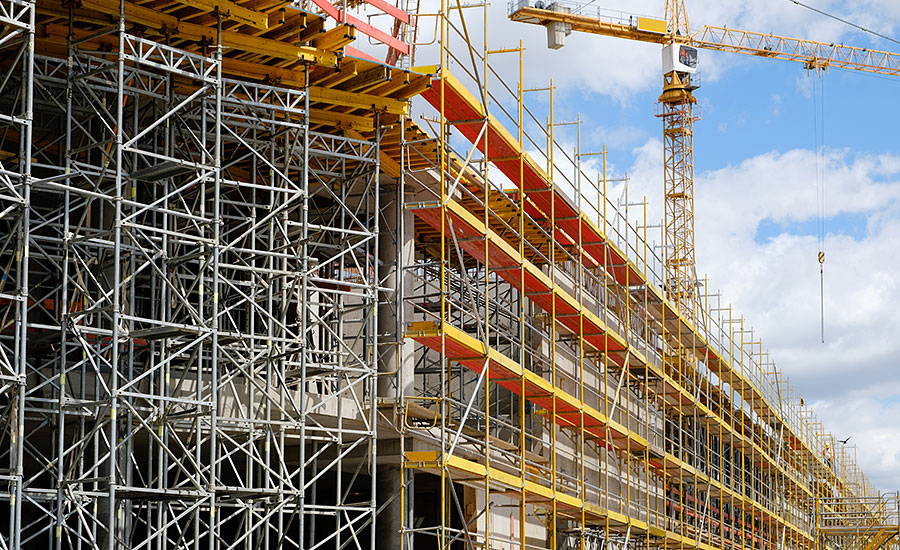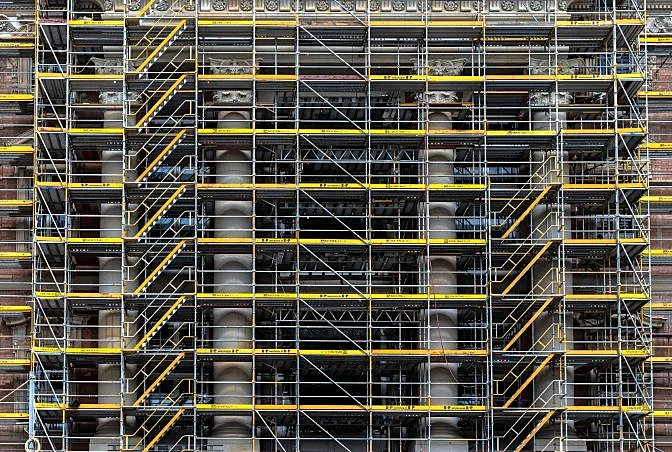Local Scaffolding Company Providing Reliable Services Throughout Surrey
Local Scaffolding Company Providing Reliable Services Throughout Surrey
Blog Article
The Conveniences of Scaffolding for Safety and Effectiveness in Structure Projects
Scaffolding is a vital component in the world of building, substantially contributing to both safety and operational performance. The effect of scaffolding prolongs beyond standard security measures; its strategic execution can change job timelines and results (Scaffolding).
Enhanced Employee Safety And Security

Boosted worker security is a paramount worry in the building sector, where the threats connected with drops and accidents can have alarming repercussions. Reliable scaffolding systems play a critical function in mitigating these threats by supplying stable systems for employees at elevated elevations. By guaranteeing that scaffolding is effectively set up and kept, building firms can considerably reduce the probability of drops, which are among the leading reasons of workplace injuries and deaths.
In addition, scaffolding enhances security via its design attributes. Guardrails, toe boards, and non-slip surfaces add to a protected workplace, lessening the risk of mishaps. Furthermore, scaffolding enables workers to access hard-to-reach locations without the need for makeshift remedies, which can jeopardize safety standards.
Educating employees on the correct use of scaffolding is just as important. Making sure that employees are experienced regarding load capabilities, setting up procedures, and security protocols additionally enhances the efficiency of scaffolding in protecting against mishaps. To conclude, including durable scaffolding systems within construction tasks not only improves worker security but additionally advertises a culture of safety that profits the entire workforce while enhancing overall efficiency.
Improved Gain Access To and Mobility

Moreover, scaffolding permits the convenient transportation of tools and materials, reducing downtime linked with relocating tools. Employees can effectively access different areas of a job, which is especially crucial in intricate builds where upright and horizontal motion is frequent - Scaffolding. This availability not only improves operations but additionally makes it possible for groups to react swiftly to altering project demands
Additionally, scaffolding can be customized to fit certain site conditions, boosting flexibility in limited or irregular rooms. This flexibility makes certain that building and construction tasks can proceed smoothly, despite the obstacles provided by the atmosphere. By fostering improved access and mobility, scaffolding plays a vital function in supporting building and construction staffs and enhancing the total efficiency of building projects.
Enhanced Project Efficiency
In construction, task performance is substantially affected by the efficient use scaffolding systems. By providing a secure and stable system for workers, scaffolding minimizes downtime and speeds up the speed of building and construction activities. With better access to raised workspace, groups can complete jobs faster, decreasing the total project timeline.
The modular nature of contemporary scaffolding enables fast setting up and disassembly, enabling quick changes between different stages of a project. This versatility not just enhances process but likewise adds to better control among different professions, as several groups can work all at once on different areas of a framework.
Moreover, scaffolding ensures that workers are located correctly to do their tasks without unneeded pressure or risk of injury, therefore minimizing the likelihood of mishaps that can bring about costly delays. Boosted precaution embedded in scaffolding systems, such as guardrails and toe boards, more assistance reliable procedures by maintaining employee concentrate on the job available as opposed to safety worries.

Flexibility for Numerous Jobs
Scaffolding systems stand apart for their flexibility across a large range of construction jobs, efficient in meeting certain website requirements and tasks. Their modular style permits for quick modifications to fit numerous building types, from property to business frameworks, ensuring that workers have risk-free accessibility at various heights and angles.
These systems can be tailored for diverse applications, such as frontage work, interior remodellings, or durable commercial tasks. For instance, lightweight aluminum scaffolds are suitable for indoor job, while robust steel frameworks supply the essential support for massive building and construction. The versatility of scaffolding encompasses its capability to be set up for both temporary and permanent frameworks, permitting professionals to effectively prepare and perform their jobs.
Additionally, scaffolding can be utilized in difficult atmospheres, including city setups where space is minimal or on unequal surface where standard gain access to options are not practical. This adaptability minimizes the requirement for multiple gain access to remedies, decreasing prices and job timelines. By fitting a selection of tasks and problems, scaffolding boosts the total performance and efficiency of building efforts, confirming to be an essential property in the structure industry.
Conformity With Safety Requirements
How can building tasks guarantee the safety and security of workers while preserving performance? Regulatory frameworks, such as OSHA in the United States, supply guidelines that regulate the usage of scaffolding, guaranteeing that it satisfies strict security standards.
Proper scaffolding design and setup play a critical role in compliance. Scaffolds need to be created from top quality materials and created to hold up against the specific loads they will experience. Routine assessments and upkeep are crucial to ensure that these structures remain safe throughout the project duration. Training workers on safe scaffold use and the importance of compliance with safety requirements even more strengthens a culture of security on-site.
Furthermore, paperwork and record-keeping pertaining to safety inspections and employee training are crucial. These methods not only show conformity however also provide liability and transparency. Ultimately, by focusing on adherence to safety and security requirements, building projects can cultivate a much safer work setting, consequently enhancing productivity and performance without jeopardizing worker safety and security.
Final Thought
In final thought, scaffolding acts as an scaffolding over conservatory essential element in structure jobs, dramatically improving safety and efficiency. Its style features, including guardrails and non-slip surface areas, add to a much safer working environment while assisting in improved accessibility and movement for employees. The modular nature of scaffolding promotes quick assembly, thus raising general project performance. Adherence to safety requirements highlights the relevance of scaffolding in this post accomplishing successful task end results, making it indispensable in the construction industry.
Scaffolding is a crucial part in the world of construction, significantly contributing to both safety and operational efficiency. The impact of scaffolding extends beyond basic safety and security measures; its strategic implementation can transform task timelines and end results. In verdict, including durable scaffolding systems within building jobs not only improves worker safety but also advertises a society of safety and security that profits the entire workforce while enhancing overall performance.
In verdict, scaffolding offers as a crucial element in building projects, dramatically boosting security and effectiveness. Adherence to safety standards emphasizes the value of scaffolding in accomplishing successful task results, making it vital in the building market.
Report this page